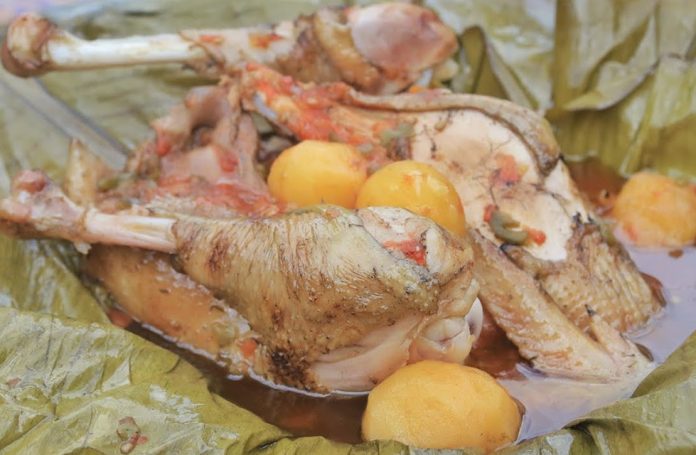Uganda is East Africa’s food basket. This East African country grows a lot of food – from matooke in Central region to cereals in northern Uganda and Irish potatoes in South Western Uganda, Uganda has the richest diversity when it comes to food!
- Luwombo
Luwombo is a traditional Ugandan stew dish that is made from beef, mushrooms, chicken or fish steamed in banana leaves. It is both a royal and a fairly common dish cooked especially during the holidays. Luwombo is said to have been created in 1887 by the personal chef of Kabaka Mwanga, who ruled the kingdom of Buganda at the end of the 19th century. The dish consists of beef or chicken with vegetables wrapped in banana leaves and steamed to perfection with just the right amount of salt and spices. It is considered special for many reasons including the way it is presented; wrapped in leaves like a gift.
- Akaro or Millet
Historically, kalo is a delicacy among the ethnic agrarian tribes in the western part of Uganda including the Bakiga, Banyankole, Batooro and Banyoro as well as some tribes from eastern Uganda including the Bagwere.
In a family setting, the kalo is served differently especially in Ankole. There is a special basket (endiiro) used by the head of the family and other baskets for the rest of the family members. It is good to leave the kalo covered up for 10-15 minutes before serving so that it tastes tender. Some people will even pass it over their head before chewing it but they have to ensure they don’t allow it to get cold.
After mixing and squeezing the kalo into a dome, a basket matching the size of this dome is prepared. Raw flour is sprinkled onto the walls of the basket before the entire blob of kalo is hurled into the basket. The raw flour is meant to prevent the Kalo from sticking onto the basket’s walls.
It is cooked similar to posho but has a higher protein content and heavier taste. It is dark brown in color and is called millet “bread” when mingled although the texture is sticking rather than bread like. It is especially delicious served with peanut sauce containing smoked fish. Millet flour can also be boiled in water for a nutritious porridge best served with milk and sugar.
Millet is a tiny bead shaped grain that must be husked then winnowed and finally stone ground after harvest; but first it is meticulously weeded. The Bagisu tribe has a saying if a task is particularly difficult – it is said to be “like weeding millet.” Since the grain is dried on the ground after reaping, good millet should be sand free when cooked. Kalo is becoming ever more popular every day, not only for its beneficial nutrients but also due to the new craze in traditional foods. Other Ugandans are returning to eating traditional dishes under the guise of healthy feeding.
- Posho
Winning the gold medal for all time most favorite food of the majority of Ugandans is posho. It is similar to polenta in Italian cuisine. It is not sweet or savory but instead takes on the flavor of whatever soup it is served with. Posho is made up of white corn flour mixed with boiling water until it becomes solid. It is not easy to cook as it must be “mingled” thoroughly and becomes stiff while mixing.
This heavy food is prized for its “fill you up” ability and it doesn’t have to be peeled, washed, sorted or soaked like some other things. Maize is relatively easy to grow and there are grinding mills in every village so people in Uganda prefer to grow their own corn and then have it into flour as needed. The flour can also be obtained in large quantities already milled. No wonder it is used by all boarding schools as their main staple food.
- Chapatii
In almost every place where people are, there is a guy selling chapatti. A dinner plate sized chapati usually sells for 500 Ugandan shillings. Chapattis are made from wheat flour, water, salt and sometimes a little baking powder. They are rolled out like a pastry crust but are more hardy and elastic in texture. After frying in a cast iron skillet with a generous portion of oil they are thick and flaky. They are sold wrapped in a bit of news paper or polythen bag so the person eating doesn’t have to wash their hands first. They can be eaten alone, with eggs or with bean and meat soup. They are better hot but even cold are acceptable fare. Some families prepare chapattis for themselves. If you are on a road trip in Uganda chapattis are a must.
- Rice
Any special occasion demands rice. It is grown in mostly in the eastern part of Uganda. People of Uganda prefer white rice simply boiled in salted water or fried with oil and onions then boiled in beef for a pilau type dish. Rice is difficult to grow and is harvested by hand; it is therefore too expensive to eat every day. It is also very time consuming to sort. It is a delight to eat but rather labor intensive. A few kilos of rice make the perfect gift for any Ugandan host!
- Matooke
There are a variety of bananas in Uganda, some are used to make juice while others are for food. Matooke is the type that is picked green and must be cooked. It is usually steamed in its own leaves and must be eaten hot as it hardens quickly when cooled. At times, it is prepared in different ways mixed up with some soup like Gnuts.
It is very expensive and is only grown in certain areas of the country. It takes a special skill to peel the bananas and this tends to be an indicator of a woman’s skills in general. It is mashed after steaming and served hot. Like rice, Matooke is a must for every special occasion.
- cassava
The king of starchyness; cassava definitely needs to be prepared properly. It can become bitter if not cooked immediately after harvesting. It has limited nutritional value but can be dried and pounded into flour to make porridge more filling.
A root that takes one to two years to grow, cassava is easy to harvest and grows well even in drought. Cassava is considered a poor man’s food. It is usually boiled in huge chunks and served with soup or can be sliced thinly and deep fried in oil for an added extravagance. When diced and boiled with beans it is called “Katogo” and is very nice for lunch and some people rely on it for a hardy breakfast!
- Sweet Potatoes
These come in various colors on the outside but are usually white and yellow inside. They are more hardy that the American yellow variety and do not fall apart or turn soggy when cooked.
They are grown in mounds of soil and are eaten shortly after harvest. For the most part, they are peeled and boiled whole in water. They are also good served with peanut sauce. Their sweet taste contrasts the saltiness of pinto bean soup for an excellent combination.
- Irish Potatoes
This is what we just call potatoes. They are very expensive and do not keep long in this climate. They usually are russet type and are served simply boiled or fried in tomatoes after boiling. Mashed potatoes would be very expensive due to the butter and milk required plus they are considered baby food. French fries (or chips as they are called here) are served in larger restaurants but cannot be found in small towns. They are not considered food but rather they fall under the snack category.
- Katogo
A traditional and heavy breakfast dish that can be eaten during the day, katogo consists of fried plantains with soup and beef, beans, G-nuts spiced with vegetables. This meal is popular with Ugandans and often served as early as nine in the morning. Pumpkin is a vegetable although it is not usually prepared as soup. It is usually cut into large pieces unpeeled and steamed. It is served as a side dish. Some are not true pumpkins but are a type of summer squash. The seeds are soaked in salt water and roasted for a special treat.










